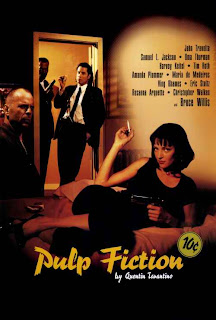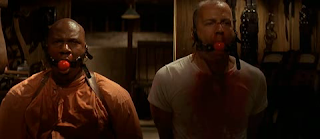Poj Arnon
2007
No, this is not a love story. Detestable and an insult to the human spirit it is to entitle itself as one. This crime-action-gay-romance-drama is a painful and a horrible piece of thrown-away snatches of tearjerking images on its most irrational form. The overwhelming drama is verging on loathsomeness and its indulgence is apparently an absolute tomfoolery. The logic of the reality of life has been reduced by the excessive employment of sentimentality where life continues to transmute itself to a pinnacle destitute of happiness. Melancholia is the only stead this Thai movie can go to, or maybe an abyss of one. Moreover, the ultimate culprit in this uncollectible film by Poj Arnon is not just the emotionally bruising story, but also, its horrendous narrative and crude direction. Surfeit content and an indelicate form is the formula for the staggering stray of “Bangkok Love Story”.
The scenes inside Maek's place, the warm colors and the over-all production value is probably the most well photographed scenes in the whole film.
The movie is about a hired killer and a supposed target who would obviously find affection to one another. Then you have the disillusioned and extremely struggling family of the hired gunman, Maek, played by Rattaballung Tohssawat, whose mother is ridiculously weak and conceivably dying from AIDS and his younger brother who is the same disease-inflicted-turned-male-prostitute-who always-gets-beaten-by-the-local-gang-on-his-way-home-buying-food-for-his-mother-who-through-intercut-coughs-seriously-eventually-vomitting-blood. Then, you also have the big bad guys, haunting the two men. Then, you have the target, Iht, a cop, played by Chaiwat Tongseang, who turned sour to his wife and finally leaving her to follow the feeling which according to him has became so strong he doesn’t even know how to describe—which is sweet. Then, you have Maek, trying to hide away his feelings from Ikh and the final gun-fight scene, the chasing scene of Maek by the police, his imprisonment, the suicide of Maek’s brother, Mhok, played by Weeradit Srimalai, the loss of Ikh’s sight, and the death of Maek after Ikh waited for him for his release in the prison for years. Obviously, that is a megalith of a drama! The story seems to have its motivation to push forward from a curse. The convenience of imposing pain and sorrow to paint his characters is absolute, as if these characters are simply meant to be broken and punished. I completely hated that. One of the best lessons I ever treasure and one that deeply struck my mind came from my screenwriting professor, according to him; there is only one thing that propels a storyline, an energy that forwards a film, and we are all unconsciously aware of that mysterious force—that is Love. “Bangkok Love Story” has love in its façade, but it is not on its arsenal. Arnon’s biggest mistake is to commit pain and anguish on his film’s strongest suit, instead of love. Agony bellows the whispers of promise and mishaps devour the human heart. The conflict in this drama is insanely ubiquitous; some in suspecting plantings but most in staggering shockers bordering on irrational.
The technical is not even exceptional. The cinematography intends to get too dim at night and gritty at day capturing that 3rd World City
This scene, and the whole movie, is absolutely no "Love of Siam."
Going back to the overabundance of drama, a clean-cut, good, coherently concocted drama film usually only has 2 or 3 scenes of the most heart-rending revelations and realizations. “Schindler’s List” has one. “A Beautiful Mind” has one, and “Finding Neverland” has one as well while “Bangkok Love Story” probably has 10. As a consequence, the expected intensity of these bragging moments degraded severely. I believe, it is an issue with the screenwriter. He should have cut more than half of those what-he-thought-as-brilliant poignant sequences and use them to his future projects. There are really only 2 scenes from those many a tearjerker scenes that are truly captivating. First is when Mhok is waiting for Maek at the train station for them to go away and just when he thought his brother came for him, police were right behind him leaving him alone and away from the life the two of them are just about to start few minutes ago. Second is during the voice-over of Mhok reading his suicide note to his brother; there is the line where he said—I will see you in heaven…but I have to go now, I have to leave you first….from then on, my life stopped (referring to the time when he acquired the disease); and then an intercut on a low angle shot showing Mhok hanging himself on a swing. Those two alone, minus 5 or 6 of the other big scenes could have redeemed the film who sees the world as a reality of despair. It requires a lot of emotion from the audience which is hard because they are required in the most unexpected time like a boxer in a ring without months of training.
There is no way you will see this love scene in the real world. This is too unrealistically cinematic.
This is also a complete anti-gay film. There is no way homosexuality has been celebrated or even been recognized or addressed. You know it exists because of the two men involved, male prostitution and sexual abuse but it didn’t let us know anything new about homosexuality than a cause to an unspeakable, never-ending doomed life. It has no hope. It kills love. It just wants us to cry. I even think that it doesn’t deserve tears from film enthusiasts because the supposed beauty of misery is not there. Films are not like that. They don’t simply present sorrow. They don’t simply present weeping. They don’t simply present death. Instead, they show that mystifying beauty in sorrow. They denote acceptance in weeping. They dedicate redemption in death. That is film! They show beauty in despicability and not just despicability.












































